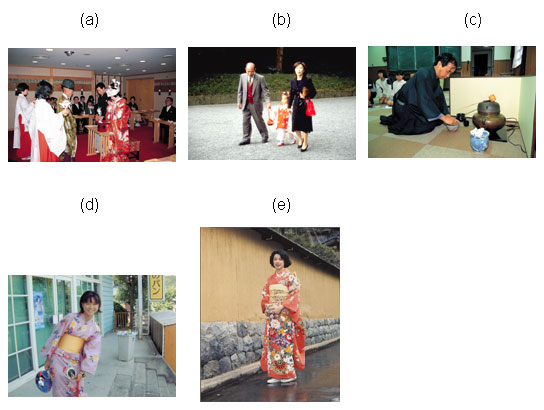
|
Title |
着物はいつ着る? |
|
Unit/Activity No. |
Fashion/Activity 3 |
|
Topic |
Clothing, calendar, holidays |
|
Function |
Identifying things, describe |
|
Focus |
Vocabulary for things related to kimono |
I. BACKGROUND INFORMATION FOR TEACHERS
Teacher Instructions
Answer Key to Student Activities
Handout 1
a. b. d. f. g. i. j. (Japanese people most likely wear kimono on these occasions, but the answers could vary.)
Handout 2
1. 1) d 2) a 3) b 4) c 5) e
2. 1) b 2) d 3) c, e 4) a 5) f
3. 1) f 2) d 3) e 4) b 5) a
6) g 7) c
II. STUDENT ACTIVITY HANDOUTS
Handout 1
Contemporary Japanese wear a kimono only on special occasions. When do you suppose they commonly wear a kimono? Circle the occasions.
a. 結婚式1 b. 成人式2
c. 誕生日3 d. 正月4
e. 買い物 f. 夏祭り5
g. 卒業式6 h. 旅行7
i. 葬式8 j. 茶会9や生花10の会
<Useful Vocabulary>
|
1. けっこんしき |
2. せいじんしき |
3. たんじょうび |
|
4. しょうがつ |
5. なつまつり:summer festival |
6. そつぎょうしき:graduation ceremony |
|
7. りょこう |
8. そうしき:funeral |
9. ちゃかい:tea ceremony |
|
10.いけばな:flower arrangement |
||
Handout 2
1. The following sentences describe specific occasions when contemporary Japanese commonly wear a kimono. Match the sentences below with the pictures.
1) ( )今日は夏祭りです。ゆかたを着て、うちわをもって、ぼんおどりをします。
2) ( )神社1で姉2の結婚式がありました。姉は着物をきて、とてもきれいでした。
3) ( )私が七才の時の写真です。七五三の日に、家族と神社にお参り3しました。
4) ( )茶道4の先生です。私は一週間に一回、茶道のけいこに行きます。
5) ( )成人の日の写真です。着物を着て、写真をとりました。
<Useful Vocabulary>
|
1. じんじゃ |
2. あね |
3. おまいり |
|
4. さどう |

2. Fill in the blanks with the most appropriate words from the list below.
1) 京都(きょうと)には寺(てら)や___がたくさんあります。
2) お正月に神社に___しました。
3) ___を着て、___を持ってまつりに行きました。
4) ___でぼんおどりをしました。楽しかったです。
5) ___は子供が三才、五才、七才になった時にするおいわいです。
|
a. まつり b. 神社 c. ゆかた d. お参り e. うちわ f. 七五三(しちごさん) g. 成人の日 |
3. Match each of the Japanese vocabulary word with the English translation.
|
1) |
まつり |
・ |
・ |
a. |
Fan |
|
2) |
神社 |
・ |
・ |
b. |
Worship |
|
3) |
ゆかた |
・ |
・ |
c. |
Coming of Age Day |
|
4) |
お参り |
・ |
・ |
d. |
Shrine |
|
5) |
うちわ |
・ |
・ |
e. |
Cotton kimono |
|
6) |
七五三 |
・ |
・ |
f. |
Festival |
|
7) |
成人の日 |
・ |
・ |
g. |
Festivity for children at age three, five and seven. |
III. VISUAL AIDS FOR TEACHERS
For the visual aid, make a transparency of the handout.